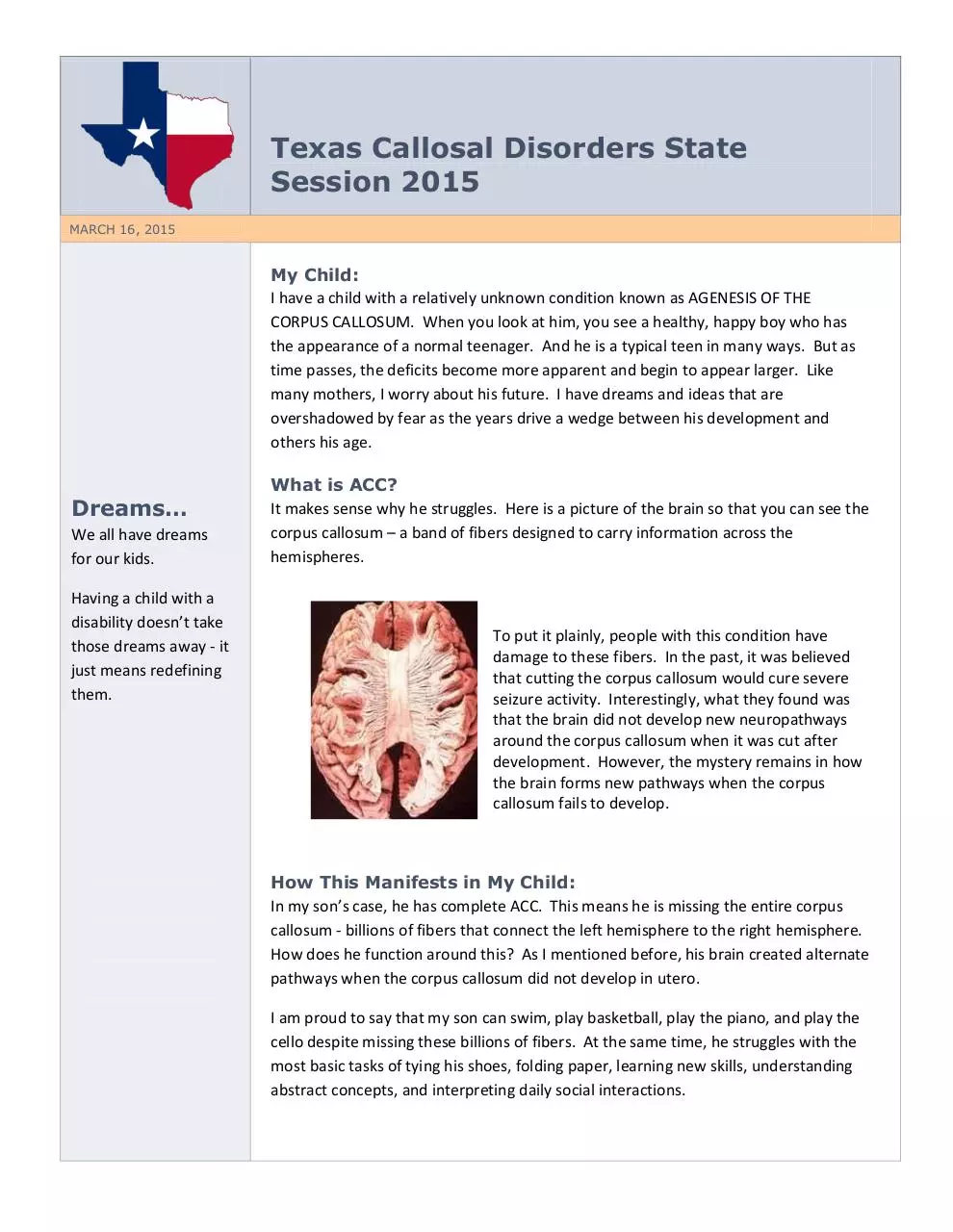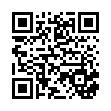Texas Callosal Disorders State Session 2015 (PDF)
File information
Author: Kim
This PDF 1.5 document has been generated by Microsoft® Word 2010, and has been sent on pdf-archive.com on 15/03/2015 at 21:15, from IP address 70.112.x.x.
The current document download page has been viewed 359 times.
File size: 201.27 KB (3 pages).
Privacy: public file



File preview
Texas Callosal Disorders State
Session 2015
MARCH 16, 2015
My Child:
I have a child with a relatively unknown condition known as AGENESIS OF THE
CORPUS CALLOSUM. When you look at him, you see a healthy, happy boy who has
the appearance of a normal teenager. And he is a typical teen in many ways. But as
time passes, the deficits become more apparent and begin to appear larger. Like
many mothers, I worry about his future. I have dreams and ideas that are
overshadowed by fear as the years drive a wedge between his development and
others his age.
Dreams…
We all have dreams
for our kids.
Having a child with a
disability doesn’t take
those dreams away - it
just means redefining
them.
What is ACC?
It makes sense why he struggles. Here is a picture of the brain so that you can see the
corpus callosum – a band of fibers designed to carry information across the
hemispheres.
To put it plainly, people with this condition have
damage to these fibers. In the past, it was believed
that cutting the corpus callosum would cure severe
seizure activity. Interestingly, what they found was
that the brain did not develop new neuropathways
around the corpus callosum when it was cut after
development. However, the mystery remains in how
the brain forms new pathways when the corpus
callosum fails to develop.
How This Manifests in My Child:
In my son’s case, he has complete ACC. This means he is missing the entire corpus
callosum - billions of fibers that connect the left hemisphere to the right hemisphere.
How does he function around this? As I mentioned before, his brain created alternate
pathways when the corpus callosum did not develop in utero.
I am proud to say that my son can swim, play basketball, play the piano, and play the
cello despite missing these billions of fibers. At the same time, he struggles with the
most basic tasks of tying his shoes, folding paper, learning new skills, understanding
abstract concepts, and interpreting daily social interactions.
ACC and Autism
My Philosophy:
My view of a disability
is that we all have at
least one thing that
limits our ability to
take part in
something. Maybe
you had an injury that
prevents you from
doing yoga or climbing
stairs, and you have to
refrain from that
activity or simply avoid
stairs. Technology has
allowed us to create
accommodations to
help individuals access
what they need by
engineering elevators,
ramps, automatic
doors, read-aloud
programs, calculators,
even apps to help the
blind see with a
camera phone. I
believe it is our duty
as a community to
help one another –
especially those less
able.
ACC is a spectrum with a full range from high to low functioning. People with this
condition can suffer from seizures, physical handicaps, and an array of cognitive
impairments. ACC “symptoms” share many similarities with Autism – behavioral
difficulties, social deficits, intellectual impairments, hyperactivity. But unlike Autism
(which does not have a specific physiological or genetic characteristic to define itself
as a disability), ACC has a verifiable diagnosis using MRI technology. You can clearly
see whether or not the corpus callosum is missing, fragmented, or impaired.
Why Does This Matter?
Some individuals with ACC struggle with accessing needed therapies due to insurance
companies either limiting coverages or simply not covering them at all. In schools
around the country, kids do not always qualify for 504 of Special Education services
with this diagnosis alone. To put this into perspective: Why is my youngest son, who
was diagnosed with Autism by doctors simply using observations and feedback from
parents and teachers, able to received unlimited therapies; whereas, my son with
ACC, who was diagnosed by a neurologist using tangible MRI results, not able to
access the same unlimited therapies?
Why Might This Be Occurring?
Lack of awareness – Without awareness, businesses make charitable
donations to other, more well-known causes. It’s not in the media very often,
but did you realize that the movie Rain Man is based on Kim Peek’s specific
ACC diagnosis? Lack of awareness results in this disability being underfunded.
Lack of funding: Without money, research will not occur. And without
research, awareness suffers.
Poor research: Without research, medical insurance providers do not have
the scientific backing to cover needed therapies or to exclude limitations.
Poor research also impacts pregnant mothers who are being given the option
to terminate pregnancies without enough information to make an informed
decision.
Poor understanding: Lack of understanding trickles down to schools and
limits kids’ abilities to access special education and 504 services. ACC is
currently not a qualifying disability unless attached to Autism, learning
disabilities, under the “other health impaired” category, or any other
qualifying area.
What Can We Do About This?
Texas Callosal
Disorders State
Session June 2013
Registration:
http://www.payitsqua
re.com/collectpage/48007
1. Band together in your state, meet regularly, hold conferences to pull together
knowledgeable experts in your area so that voices will be heard.
2. Educate everyone around you so that ACC becomes a household name – as
well known as Autism.
3. Donate to the NODCC. This is a national organization that is rapidly growing.
The NODCC collaborates with other ACC organizations around the world
(Australia and Brazil) and works with leading doctors in the field who are
researching in the United States. Right now, the leading specialists are in the
state of California.
4. Encourage research and government funding. Brain research is important and
needs to be furthered to widen our understanding of how the brain functions.
Implications of this can help treat people beyond ACC including those with
traumatic brain injuries, stroke survivors, people with epilepsy, and even
Autism.
How Texas is Impacted:
I live in the great state of Texas. I am proud to be a Texan, but I am not too proud to
admit that WE NEED MORE KNOWLEDGABLE DOCTORS AND RESEARCHERS to support
and guide us in this big state.
Formal Gathering:
On Saturday, June 13, 2015, Texas families who are impacted by ACC (any form of
callosal disorder) are gathering to learn more about available supports and services in
Texas. This state session is designed to connect families together, share stories of
hope, and simply provide a time to come together with a common purpose - to
increase knowledge and understanding and to encourage research and funding.
We all have dreams for our kids. Those dreams are possible within a supportive
community working together on a common goal!
Hope to see you on June 13th!
Download Texas Callosal Disorders State Session 2015
Texas Callosal Disorders State Session 2015.pdf (PDF, 201.27 KB)
Download PDF
Share this file on social networks
Link to this page
Permanent link
Use the permanent link to the download page to share your document on Facebook, Twitter, LinkedIn, or directly with a contact by e-Mail, Messenger, Whatsapp, Line..
Short link
Use the short link to share your document on Twitter or by text message (SMS)
HTML Code
Copy the following HTML code to share your document on a Website or Blog
QR Code to this page

This file has been shared publicly by a user of PDF Archive.
Document ID: 0000215357.